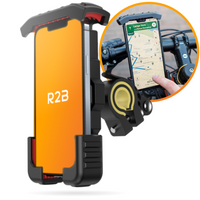No Products in the Cart

Corona test in the office
Time to read 4 min
Time to read 4 min
Since March 2020, the Netherlands has been working on a '1.5 meter society'. This means, among other things, as little physical contact as possible by keeping a distance of 1.5 meters or more. While shopping, in the supermarket or just on the street: people walk around each other in an arc.
But how do you do that in the office? Not all people are able to work from home, because they have a crucial profession. And what happens after January 19, when the current lockdown ends? If the corona figures decrease, the current measures are expected to weaken slightly, but working from home will remain the norm. But what will change if the government and the RIVM indicate that it is possible to go to work again?
We briefly summarize how the 1.5 meter measures can be enforced without weakening communication at work.
EntranceWorking at 1.5 meters starts upon entering the office building. Clear markings on the ground prevent people from walking or coming too close to each other. Clear arrows on the ground with a good dividing line should be sufficient. An important point of attention is to clearly indicate where the entrance and exit are, for example by hanging up a piece of paper. If possible, make sure this is not the same door.
Prevention screensYou have probably already come across them in the supermarket, gym or shops: splash guards, or prevention screens. These screens are transparent and prevent contamination between people. It is not always possible to maintain the 1.5 meter distance at work, for example because the space is too small. The same applies to office spaces where the 1.5 meter distance cannot be maintained. Placing prevention screens between desks offers a safe solution. The image of prevention screens in an office will become a normal thing.
Disinfectant hand gelIn addition to keeping your distance, physical contact is not allowed. A virus can survive for a long time on hands and surfaces. A virus on the skin can survive for at least 9 hours if not washed or wiped properly. On metal and plastic even a few days, depending on the humidity. That means one thing: cleaning.
Disinfectant gel must always be placed in a visible place in common areas, such as a kitchen or toilet.
Alternative doorknobsDoor and window handles are places that are used and touched by several people. An infection can still be transmitted as a result. Fortunately, there are plenty of alternatives on the market to circumvent this. There are special holders that allow you to open a door or window with the elbow. There are also special key cords in circulation that allow doors to be opened without touching a handle. You will probably encounter this more often in the future.
Communal areas are being adaptedCommunal areas are adjusted so that the 1.5 meter distance can be maintained. For example, consider removing certain desks and chairs and marking where you are and are not allowed to sit and stand. Tables will be pushed apart and there will be a maximum number of people allowed in a room. This of course depends on the size of the room.
Online meetingsThis is still a bit awkward for many, but online meetings are the topic of 2020. Many important meetings, for example with potential customers, will take place online. Where it used to be the norm to receive customers at the office, you now also receive them at the office, but online.
Having lunchUnfortunately, having lunch together with colleagues will be a lot less fun. After all, the 1.5 meters must be maintained. A canteen is a communal space with a maximum number of people. So keep in mind that you will have to eat alone at your desk more often.
Of course it is also possible to take a walk with a colleague. That is of course a lot more pleasant, but keep the 1.5 meter rule in mind. Moreover, a little extra exercise and getting some fresh air is never bad for the body!
Own materialMake sure that only your own belongings are used. Think of your own keyboard, mouse and your own mug. If everyone takes care of their own belongings, the risk of transmitting infections will also be reduced.
Cleaning the workplaceIt is essential to keep the workplace clean. Not only for inhibiting viruses, but also for productivity. This probably means cleaning every day. Knowing more? Read our previous blog about keeping the workplace clean .
Ventilate airGood ventilation is necessary for a healthy and pleasant indoor climate. It also helps to limit viruses. Good ventilation systems are therefore necessary, but working with the window open also works wonders. So dress a little warmer if necessary!
A small reminder of the agreed measures drawn up by the government and the RIVM:
As a final point, we would like to point out that it is important to speak to colleagues and customers if you notice that they forget to adhere to the established 1.5 meter distance. A small moment of carelessness can always arise. Together we are strong and we can handle the virus!
